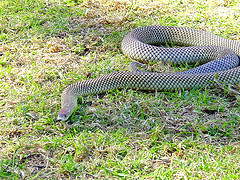
Australia has some of the world’s deadliest snakes, and snake bites in Australia most commonly happen in the warmer months when snakes are more active. They mainly live in rural and remote areas and are found out and about on farms looking for water or food.
Snake bites often occur if a snake needs to be defensive. Common sites to be bitten are hands, arms, feet and ankles. Medical assistance is required urgently after a snake bite.
Do not attempt to catch the snake. The snake may bite again if an attempt is made to catch it. Identification of the snake species can be obtained in the hospital through patient samples of blood and urine.
Symptoms of snake bite may include:
- pain
- local effects – swelling or bruising around the bite
- widespread effects – including abdominal pain, nausea, vomiting, blurred vision, slurred speech, muscle weakness and respiratory distress.
First aid for snake bite aims to stop the venom moving around the body. Depending on the volume of venom injected, research indicates very little venom reaches the circulation if pressure is applied over the site and the limb is immobilised. If the snake is angry and stirred up, it may release more venom when it strikes.
What you should do:
- Call an ambulance
- DO NOT wash the bite or attempt to catch/kill the snake.
- DO NOT apply a tourniquet or remove clothing.
- Apply pressure to the bite area.
- If a limb is bitten, bandage the area of the bite firmly with a broad (10-15cm wide) pressure bandage (as firmly as you would for a sprained ankle).
- Apply another broad bandage starting at the toes or fingers and bandage up the limb as far as possible.
- Crepe and compression bandages are ideal – but use anything available if no bandages are available. E.g., tearing up a shirt, towel or sheet.
- Splint limb to prevent any muscle, limb or joint movement.
- Mark the bandaged area over the snake bite with an X. This will allow health professionals to quickly locate the bite without removing the bandage.
- If the bite is to the trunk or torso still apply a firm bandage.
- If the bite cannot be bandaged then apply and keep constant firm pressure.
- Keep still, remain calm and try not to panic. Movement and panicking will cause the venom to circulate faster.
- Activate your emergency plan to get help and medical assistance urgently
- If the snake bite victim collapses or stops breathing, apply CPR (cardiopulmonary resuscitation) until medical help arrives.
Fast facts:
- Avoid being bitten by a snake.
- If bitten – don’t panic and don’t try to catch the snake.
- Follow basic first aid for a snake bite, even if you’re not sure if the snake was venomous.
- Don’t wash the skin, venom traces may help identify the snake.
- Send for help by calling triple (000) immediately.
- Remain still and calm until help arrives.
- Do not raise the limb.
References used for this topic
More information:
Department of Environment and Heritage Protection (Qld)
Snake bites
Flying Doctors Service
Outback Survival: Snakes and snake bites
St John Ambulance Australia (Vic)
Snake bite first aid tips
Clinical care:
Safer Care Victoria
Management of snake bite
Research & reviews:
The Medical Journal of Australia
The Australian Snakebite Project, 2005–2015
World Health Organization (WHO)
Snake antivenoms
|
|